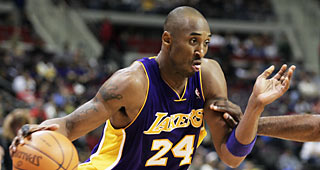The months of October, November, and December were very kind to the Lakers. Of the first 33 opponents on the Lakers' schedule, only eight currently sit above the .500 mark. Yet despite the easy early schedule, the Lakers (32-13) are two games behind last year’s pace. And with 24 of their remaining 37 games against plus-.500 opponents – including 12 on the road, where the Lakers have a 2-5 record against winning teams on their homecourts – their hold on the 2nd seed in the Western Conference is hardly set in stone.
Are there really some chinks in the armor of the two-time defending champs, or is this merely a case of midseason complacency? Let’s take a look.
The Lakers rank tenth in points allowed per 100 possessions, down from fourth a year ago. Over the past few weeks, the coaching staff has implemented a few wrinkles to the team’s system, which include a focus on funneling ball-handlers baseline into the long arms of Andrew Bynum. With Bynum as the last line of defense, the Lakers are flooding the strong side with help, placing a second and sometimes third defender between the ball and the rim, with mixed success.
Los Angeles ranks fourth in opponent field goal percentage at the rim, according to Hoopdata.com, but their system of aggressively preventing points scored in the paint by way of dribble penetration has at times left them vulnerable to quick ball-reversals – resulting in open outside looks.
A year ago, Los Angeles finished first in three-point defense, limiting their opponents to 32.8 percent shooting from deep; this season, the Lakers are fifth. The data is clear: The Lakers are 25-4 this season when holding their opponents below 40 percent from three (which is actually 4 percentage points higher than the league average allowed) and just 7-9 when their opponents equal or exceed the same mark from that distance.
Also troubling is LA’s transition defense. Last year’s Lakers were 6th in fast-break points allowed per game at 12.6; this year’s edition is 21st, ahead of only Charlotte, Houston, Detroit, Washington, Sacramento, Memphis, Minnesota, Toronto, and Golden State. The Lakers have shown a fundamental weakness to get back and contest at the basket, giving up easy layups and wide-open catch-and-shoot opportunities.
Energy
According to TeamRankings.com, Los Angeles is plus-5.9 points in average margin through two quarters, far and away the best mark in the league. The Lakers fall to tenth in average 3rd quarter margin (1.2), and trade buckets (0.0) with their opponents in the all-important fourth quarter. Conventional wisdom tells you that the Lakers’ age has a lot to do with them fading over the course of 48 minutes.
Can the Lakers reverse this trend? If Jerry West is to be believed, the Lakers are near, or past, the point of no return.
Said West: “I don’t think the Lakers will be good for much longer. You can keep a car running for a long time by changing the tires, etc. You can’t change a player’s tires.” West added that many of the Lakers’ current players are “getting long in the tooth.”
Perhaps it’s the enthusiasm of third-year coach Erik Spoelstra, or the seemingly endless energy of LeBron James, but it’s worth noting the Heat lead the league in average third quarter margin (3.2).
Whatever you think of Kobe Bryant, the Lakers offense, first in points scored per 100 possessions, still relies on the spacing achieved by Bryant on the strong-side triangle, and at the weak-side pinch post. He ranks third in the league in total field goal attempts, and while most statistical analyses would conclude that Bryant is little more than a high-volume scorer, there’s still a segment (however small) of NBA decision-makers that regard Bryant as the best player in the NBA.
Bryant ranks 14th in points scored per isolation possessions (1.03), according to Synergy Sports, which logs every possession of every NBA game. Likewise, Bryant derives 16.3 percent of his offense off post-ups, shooting 47.9 percent on such situations, and ranking 30th at 0.95 points scored per possession. Bryant’s per game numbers are down, especially his three-point accuracy, which has fallen for the fourth straight year, but that decline is somewhat offset by an increase in shots attempted between 10-feet and the immediate vicinity of the basket.
Through Monday, Bryant leads all shooting guards with an average of 3.4 attempts within that distance -- more than double his average of 1.5 during his lone-MVP season in 2007-08, when he averaged 5.9 more minutes per game. This bodes well for LA’s future, as Bryant is money in the lane, at the elbows, and also if he gets to the baseline.
By the numbers, the Lakers are one of a handful of teams among the league’s top 10 in both offensive and defensive efficiency -- and fourth in point differential, the best predictor of future success, at plus-7.04. Still, signs of slippage are evident, strengthened by the fact that LA is 5.5 games behind the Spurs and unlikely to close the gap due to an unforgiving schedule to close out the season.
Comments, questions, or criticisms? Email Brandon, or follow him on Twitter.


